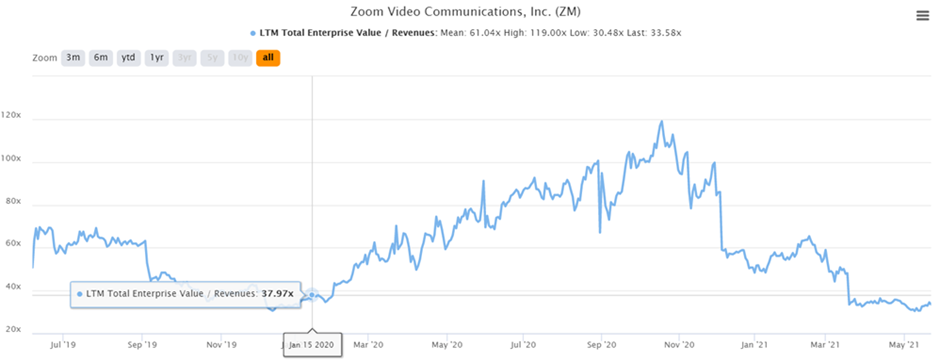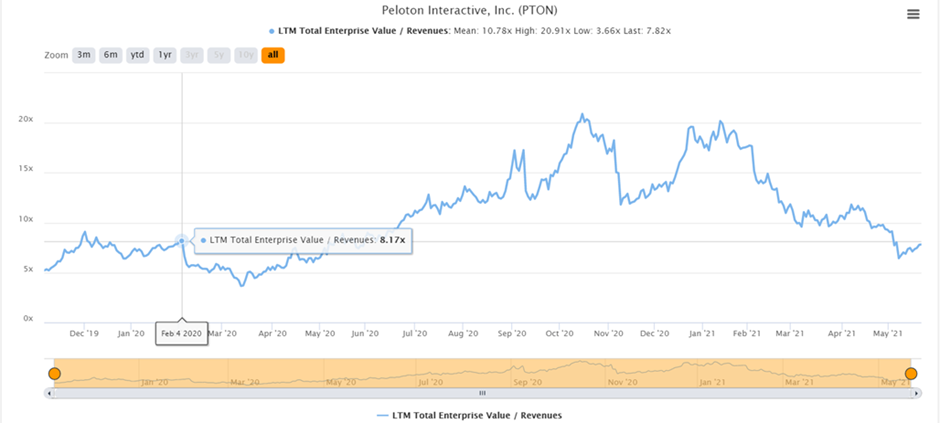Rotating out of the Rotation
In mid-February this year, growth stocks were on a tear and after a record 2020, and with continued gains into 2021, it seemed like the momentum wasn’t slowing any time soon. However, market sentiment quickly changed, with interest rate fears kicking into gear, we saw a brutal rotation out of growth stocks and into recovery (and value) plays. Granted that after a parabolic move upward in many growth companies, and valuations hitting 50-60x future sales, it seemed obvious that something had to give. This rotation let the steam out of the growth market, with SPAC companies trading below the mythical line-in-the sand of $10 and several growth stocks dropping 50-70% from their all-time highs. As stated above, money exited growth and saw itself enter recovery stocks. This makes sense. Many of these companies in the retail, restaurant, and travel space had been beaten down, and with vaccine rollouts happening across the world, it was natural that it was their time to shine.
However, several months into this rotation, we started to notice something quite strange happening with the valuation of these two segments, both of which we will explore below. We noticed several growth stocks trading at or below their pre-covid valuations but on the other hand we saw recovery stocks break past their pre-covid stock price highs despite having severely damaged businesses.
To put this in some visual perspective, let’s take a few examples. The most famous Covid winners would probably have to be Zoom and Peloton (note: we do not own shares nor have ever owned shares in these two examples). When we could not meet in person, Zoom became the go-to app for business meetings and to catchup with loved ones. Similarly, as soon as global lockdowns occurred, Americans couldn’t stop talking about paying over $2K for a bike that didn’t actually get you to your destination. For a while, their stock prices flew high with both increasing 6x from their covid-lows, but in a quick reversal of fortune, they saw a decline of 50% over the last few months. Now again, so far, no problem, as this strong correction fits the narrative we laid out above. However, upon taking a closer look at their valuations between Feb 2020 (right before lockdowns) and now, we started to notice some interesting trends.
We can see that Zoom’s valuation pre-covid was at a 38x LTM (Last Twelve Months) Sales, whereas it’s currently trading at a 10% discount to that, despite growing 88% till Jan 2020 but 325% to Jan 2021 (so lower sales multiple despite much higher growth). Besides the revenue growth, this qualitatively does seem strange as Zoom has become the dominant player in the video-conferencing space, and has reached cognitive assonance territory (i.e. not let’s do a ‘video’ call but let’s do a ‘zoom’ call). Further it does not seem likely that even in a corona-free world we’re going to go back to 100% in-office and in-person. Thus, it’s reasonable to argue that the company is in a much stronger position now, and thus should command a stronger valuation than its pre-covid self.
Peloton also follows a similar trend.
While the valuations pre-covid to now are roughly the same (currently about 6% lower), it’s quite obvious Peloton is in a much stronger position than it was pre-covid. Even with gyms reopening, the product has managed to keep its hold over users with incredibly low churn and higher LTVs for older cohorts.
We’re starting to see an interesting trend where even though companies are in stronger positions than they were pre-covid, they are trading at lower valuations. Below is a list of pre-covid vs current multiples for several growth stocks.
The above is just a quick list of companies we find interesting which are trading below their Feb 20 valuations, but there are several that are trading at or just a bit higher as well. Also, we haven’t even touched on some of the mega-caps (i.e Facebook and Baba) that are essentially trading at value multiples. While we agree that the correction in growth stocks seemed to be quite inevitable, it does seem now that the market is throwing the baby out with the bathwater on several names. Now we are aware there are several criticisms with the above analysis, namely:
Cherry Picking: The list above is 100% cherry picked, and we would agree that there are several growth companies that are trading at insane multiples despite their stocks’ correction (especially in the SAAS Space). Again, we’re not saying that all growth stocks are trading at relatively cheap multiples, just that some are.
The P/S Valuation: Value investors often say that very few companies deserve to trade at a price to sales valuation. Further, there could be an argument that all these stocks were expensive pre-covid, thus a relative valuation does not mean much. We do have some sympathy for this assessment, and only the future will tell which stocks should trade at P/S and which one should have never. In fact, we would be quite hesitant to invest in any company right now that don’t have a strong ability[1] of throwing up reasonable EBITDA/profitable levels within a few years.
Past growth is irrelevant, future growth is what matters: It is true that the next few years’ growth for some of the above names look tepid as compared to their covid numbers. However, 2021/2022 growth expectations are quite in line with pre-covid future growth expectations (i.e. before the market was aware of covid). That said, we would agree that the future matters more, but that brings us nicely to our discussion about recovery plays:
As stated in our intro, value and re-opening plays have been on a tear. If we take a look at a few charts, we’ll see that several industries are trading at stock prices far above their pre-covid highs (and at higher valuations as earnings are yet to normalize).
The S&P Retail index is trading 2x higher than its pre-covid high
All major OTAs are at a premium to their Feb 2020 stock prices
As can be seen with the above charts, several recovery industries (i.e retail and OTA) are commanding prices much above their pre-covid highs. However, unlike their covid-beneficiary cousins, these stocks are not riding high based on actual recovery numbers (i.e., their revenues and earnings are not higher than pre-covid), but rather expectations of strong future numbers. In fact, until recently the expectations for some of these stocks were so low that earnings beats have been immense, and left analysts flat-footed.
Now it’s easy to see why reopening stocks would be doing well, as there’s a strong future expectation that 2021, and perhaps next few years, will be like the “roaring-20s.” However the confidence in these plays has left us scratching our heads a little. For one, it’s almost assumed there is no chance for a resurgence of covid. It seems that the West has done a decent job of keeping the disease under control and has less political will to lockdown again. But watching what’s happening in places like Taiwan and Singapore, which are developed and still struggling with the virus, gives us pause. Second, earnings for several recovery plays could be great for a year or two, but then what? Will e-commerce not eat more of retail’s pie? Will the new normal not include a significant amount of work-from-home?
When thinking about this concept of the correction in certain growth stocks overshooting and the stock prices of several recovery plays doing the same, we came across this blog post by Gavin Baker. In it he displayed the following chart:
This chart “shows that cheap consumer stocks as measured by the GS Consumer Cheap basket have outperformed expensive, secular growth technology stocks as measured by the GS TMT US High Growth basket by 114% since July 1, 2020.” This data reinforced our thinking that the rotation that started mid-last year, is perhaps starting to go too far.
Now, markets can keep their momentum for a long period of time so none of this is to say that value/recovery won’t do very well and that growth will continue to correct. In fact many market participants have pointed to the fact that when the tech bubble burst in 2001, growth stocks corrected 70-90% (which we are far from right now). However the below chart illustrates that while the performance gap between growth/value is high, it is not nearly at the 2000 level.
Based on all of the above, we’re starting to get more bullish towards growth stocks. Also given that the crypto-bubble seems to be deflating, and that there is over $3 trillion in institutional cash sitting on the side-lines[2], in a potential inflation environment, this money will have to be invested, and given the relative performance over the last 9 months, might find itself in growth (not to mention several growth stocks have the ability to weather inflation really well).
To summarise, we’re not at all saying that the correction is over and that growth will start to outperform again, we honestly don’t know. All we’re saying is that it seems like there is a shift in trend, and it might make sense to rotate out of the rotation play. That said, we have maintained a mix of traditional ‘growth’ and ‘value’ stocks as part of our portfolio and recommendations. The common theme across our portfolio includes companies that are gaining market share in markets that are growing, thus we take any sort of rotation on the chin, have had very little churn throughout.
We hope this blog post gives you a few concepts to think about when deciding what to add to your portfolio (or take out) going forward. Thanks for reading, and happy investing!







